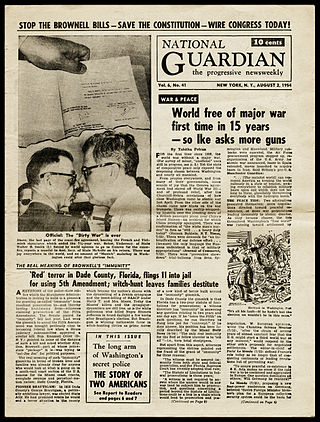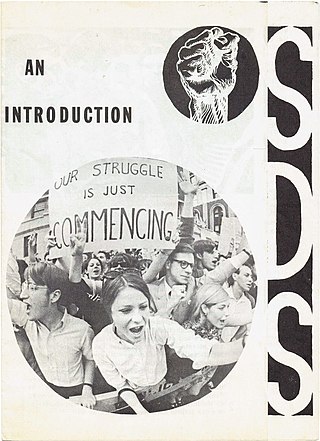
Gus Hall was the General Secretary of the Communist Party USA (CPUSA) and a perennial candidate for president of the United States. He was the Communist Party nominee in the 1972, 1976, 1980, and 1984 presidential elections. As a labor leader, Hall was closely associated with the so-called "Little Steel" Strike of 1937, an effort to unionize the nation's smaller, regional steel manufacturers. During the Second Red Scare, Hall was indicted under the Smith Act and was sentenced to eight years in prison. After his release, Hall led the CPUSA for over 40 years, often taking an orthodox Marxist–Leninist stance.

The Socialist Party of America (SPA) was a socialist political party in the United States formed in 1901 by a merger between the three-year-old Social Democratic Party of America and disaffected elements of the Socialist Labor Party of America who had split from the main organization in 1899.

The Young Communist League USA (YCLUSA) is a communist youth organization in the United States. The stated aim of the League is the development of its members into Communists, through studying Marxism–Leninism and through active participation in the struggles of the American working class. The YCL recognizes the Communist Party USA as the party for socialism in the United States and operates as the Party's youth wing. Although the name of the group changed a number of times during its existence, its origins trace back to 1920, shortly after the establishment of the first communist parties in the United States.

Communist Party USA, officially the Communist Party of the United States of America (CPUSA), also known as the American Communist Party, is a Marxist–Leninist communist party in the United States which was established in 1919 after a split in the Socialist Party of America following the Russian Revolution.
The New Communist movement (NCM) was a diverse left-wing political movement during the 1970s and 1980s. The NCM were a movement of the New Left that represented a diverse grouping of Marxist–Leninists and Maoists inspired by Cuban, Chinese, and Vietnamese revolutions. This movement emphasized opposition to racism and sexism, solidarity with oppressed peoples of the third-world, and the establishment of socialism by popular revolution. The movement, according to historian and NCM activist Max Elbaum, had an estimated 10,000 cadre members at its peak influence.

The National Guardian, later known as The Guardian, was a left-wing independent weekly newspaper established in 1948 in New York City. The paper was founded by James Aronson, Cedric Belfrage and John T. McManus in connection with the 1948 Presidential campaign of Henry A. Wallace under the Progressive Party banner. Although independent and often critical of all political parties, the National Guardian is thought to have been initially close to the ideological orbit of the pro-Moscow Communist Party USA, but this suspected association quickly broke down in the course of several years.
The history of the socialist movement in the United States spans a variety of tendencies, including anarchists, communists, democratic socialists, Marxists, Marxist–Leninists, Trotskyists and utopian socialists. It began with utopian communities in the early 19th century such as the Shakers, the activist visionary Josiah Warren and intentional communities inspired by Charles Fourier. Labor activists, usually Jewish, German, or Finnish immigrants, founded the Socialist Labor Party of America in 1877. The Socialist Party of America was established in 1901. By that time, anarchism also rose to prominence around the country. Socialists of different tendencies were involved in early American labor organizations and struggles. These reached a high point in the Haymarket massacre in Chicago, which founded the International Workers' Day as the main labour holiday around the world, Labor Day and making the eight-hour day a worldwide objective by workers organizations and socialist parties worldwide.

The Democratic Socialist Organizing Committee was a democratic socialist organization in the United States.
The League of Revolutionary Struggle (Marxist–Leninist) was a Marxist–Leninist[1] movement in the United States formed in 1978 by merging communist organizations. It was dissolved by the organization's leadership in 1990.

Dorothy Ray Healey was a long-time activist in the Communist Party USA, from the late 1920s to the 1970s. In the 1930s, she was one of the first union leaders to advocate for the rights of Chicanos and Black Americans as factory and field workers.
The Black Radical Congress or BRC is an organization founded in 1998 in Chicago. It is a grassroots network of individuals and organizations of African descent focused on advocating for broad progressive social justice, racial equality and economic justice goals within the United States.

The W.E.B. Du Bois Clubs of America was a national youth organization sponsored by the Communist Party USA (CPUSA) and launched at a national convention held in San Francisco in June 1964. The organization was active in the American student movement of the 1960s and maintained a prominent presence on a number of college campuses including Columbia University in New York City and the University of California in Berkeley. The organization was dissolved by decision of the CPUSA in February 1970 and succeeded by a new organization known as the Young Workers Liberation League. They were named after socialist and racial and social activist W. E. B. Du Bois, co-founder of the National Association for the Advancement of Colored People.
The American Left can refer to multiple concepts. It is sometimes used as a shorthand for groups aligned with the Democratic Party. At others, it refers to groups that have sought egalitarian changes in the economic, political, and cultural institutions of the United States. Various subgroups with a national scope are active. Liberals and progressives believe that equality can be accommodated into existing capitalist structures, but they differ in their criticism of capitalism and on the extent of reform and the welfare state. Anarchists, communists, and socialists with international imperatives are also present within this macro-movement. Many communes and egalitarian communities have existed in the United States as a sub-category of the broader intentional community movement, some of which were based on utopian socialist ideals. The left has been involved in both the Democratic and Republican parties at different times, having originated in the Democratic-Republican Party as opposed to the Federalist Party.

In the United States, the Revolutionary Youth Movement (RYM) is the section of Students for a Democratic Society (SDS) that opposed the Worker Student Alliance of the Progressive Labor Party (PLP). Most of the national leadership of SDS joined the RYM in order to oppose PLP's party line and what they alleged to be its attempted takeover of the SDS leadership structure, particularly at the 1969 SDS convention in Chicago.

Students for a Democratic Society (SDS) was a national student activist organization in the United States during the 1960s, and was one of the principal representations of the New Left. Disdaining permanent leaders, hierarchical relationships and parliamentary procedure, the founders conceived of the organization as a broad exercise in "participatory democracy". From its launch in 1960 it grew rapidly in the course of the tumultuous decade with over 300 campus chapters and 30,000 supporters recorded nationwide by its last national convention in 1969. The organization splintered at that convention amidst rivalry between factions seeking to impose national leadership and direction, and disputing "revolutionary" positions on, among other issues, the Vietnam War and Black Power.

The Democratic Socialists of America (DSA) is a multi-tendency, democratic-socialist, and labor-oriented political organization in the United States. Its roots are in the Socialist Party of America (SPA), whose leaders included Eugene V. Debs, Norman Thomas and Michael Harrington. In 1973, Harrington, the leader of a minority faction that had opposed the SPA's transformation into the Social Democrats, USA (SDUSA) during the party's 1972 national convention, formed the Democratic Socialist Organizing Committee (DSOC). In 1982, it merged with the New American Movement (NAM), a coalition of intellectuals with roots in the New Left movements of the 1960s and former members of socialist and communist parties of the Old Left. Upon the DSA's founding, Harrington and the socialist feminist author Barbara Ehrenreich were elected co-chairs of the organization.
The New Left was a broad political movement mainly in the 1960s and 1970s. It consisted of activists in the Western world who campaigned for a broad range of social issues such as civil and political rights, feminism, gay rights, gender roles and drug policy reforms. Some see the New Left as an oppositional reaction to earlier Marxist and labor union movements for social justice that focused on dialectical materialism and social class, while others who used the term see the movement as a continuation and revitalization of traditional leftist goals.
The history of left-wing politics in the United States consists of a broad range of individuals and groups that have sought fundamental egalitarian changes. Left-wing activists in the United States have been credited with advancing social change on issues such as labor and civil rights as well as providing critiques of capitalism.
African-American self-determination refers to efforts to secure self-determination for African-Americans and related peoples in North America. It often intersects with the historic Back-to-Africa movement and general Black separatism, but also manifests in present and historic demands for self-determination on North American soil, ranging from autonomy to independence. The freedom to make whatever choices as a free American, and willfulness to do for self are often a key demand for advocates of African-American self-determination.

Maria L. Svart is an American activist and National Director of Democratic Socialists of America, the largest socialist organization in the United States. She has been National Director since June 2011. She succeeded Frank Llewellyn, who had announced earlier that year that he was stepping down after ten years.












